Production of Chestnut Coppice Biomass in a Framework of Low Mechanization and High Expectations to Combat Climate Change and Other Social Expectations
Abstract
1. Introduction
- Wood density, a parameter that depends on the species;
- Forest management approaches;
- Working processes in forests;
- Timber handling;
- Working processes in the sawmill.
2. Materials and Methods
2.1. The Study Area
2.1.1. Context
2.1.2. Tree Composition
2.1.3. Management
2.1.4. Forest Management and the Quantification of Standing Volume
- Total height;
- Height of stem until the diameter is 8 cm;
- Diameter of stem at 8 m in height.
2.2. Wood Productions and Use
- For tree stems with prospects of long-term use, volume tables of the species “Chestnut”, under category “Volume stem and large branches (dm3)”, was used [36];
- For dead trees, parts of trees, suppressed trees or other species, the diameter at 1.30 m was measured, heights were recorded with the Vertex instrument and the taper coefficient was acquired using the Forest Management Plan.
- Chestnut wood for operational use covers 169.23 m3/ha, of which 135.38 m3/ha are destined for the sawmill, 20.31 m3/ha for energy purposes and 13.54 m3/ha released for natural decomposition;
- Dead chestnut wood, with a volume of 150.35 m3/ha, has been allocated for energy purposes at 120.28 m3/ha and 30.07 m3/ha for natural decomposition;
- Wood from other species covers 33.22 m3/ha, of which 23.25 m3/ha is for energy purposes and 9.96 m3/ha is released for natural decomposition.

- Workable wood, 20.31 m3;
- Timber for poles, 88.00 m3;
- Minor and residue material for energy use, 27.08 m3.
2.3. Wood Processing
2.3.1. Forest Management
2.3.2. Sawmill Processing
- Workable wood: larger-sized logs, reduced to planks and subjected to natural seasoning. This material is stacked in special areas, and after 3–4 years of natural seasoning, it is processed using a band saw and thickness planer to obtain sharp-edged planks.
- Poles: a wide range of products that differ in diameter and height (Table 2) and are widely used outdoors. The name of the products are specific to the local area.
- Residual wood: this category includes wood residues obtained in the first selection in the forest (defective topping, etc.) as well as waste (defective wood, etc.) obtained from the processing of stems and branches in the sawmill, with a prospective allocation on the wood market for energy use.
2.4. CO2 Dynamics
2.4.1. Calculation of Absorptions
- ML is the wood density;
- CC is the carbon content in chestnut wood;
- PA (CO2) is the molar mass of CO2;
- PA (C) is the molar mass of C.
2.4.2. Calculation of Emissions
- Indirect means, as a consequence of wood losses.
- Direct means, as a consequence of wood processing.
- (i)
- Actions: (a) forest management; (b) raw material management; (c) workable material management; (d) timber for pole management; (e) woody residue management; (f) monitoring, control and surveillance; (g) operation of the forestry company and sawmill.
- (ii)
- Sources, which are distinguished between capital equipment such as (h) forestry equipment; (i) transportation equipment; (j) equipment for internal wood handling; (k) monitoring equipment, as well as other capital equipment, such as (l) permanently invested assets; (m) emissions generated for the production of instrumental assets.
- Direct emissions, i.e., those generated by the use of instrumental assets for activities in the forest and at the sawmill. They are quantified as a product of the following variables:
- ➢
- Technical parameters [PT] (productivity, time of use, distances, etc.).
- ➢
- Energy [E].
- ➢
- CO2 conversion coefficient [CCCO2].
- Collateral emissions, meaning emissions generated by the monitoring, control and surveillance activities in the forest (letter f) (which depend on the kilometers travelled), as well as the energy used for administrative, accounting and commercial activities in the operation of the forestry company and sawmill (letter g) (quantified in terms of a percentage, equal to 0.8%).
- Remote emissions, i.e., emissions related to the CO2 emitted when the structures were built where wood processing takes place (permanently invested assets), as well as when the tools used in the processes (instrumental assets) were produced, both by the forestry company and sawmill. For both types of assets, the quantification of emissions can be determined assuming that the emissions for the production of structural capital are known [CS], and these must be related to the years of their working life [Y] and the average annual volume worked [VML], obtaining the percentage of emissions per unit of worked volume [E(%)]. Formally, it is calculated by the following equation:
3. Results
3.1. Balance Sheet of CO2
3.1.1. Balance Sheet—Active Section
3.1.2. Balance Sheet—Passive Section
The Loss of Timber
Climate-Changing Emissions
- (a)
- Forest management, which is based on the felling of the stand, excluding standards to be left as part of the forest;
- (b)
- Management of raw material, through the following:
- (b1)
- Clearing branches of all species, with the difference that for chestnut destined for construction timber, all branches are removed, while for other species and dead chestnut, stems and branches (hereafter referred to as FBR) of interest to the energy market are saved;
- (b2)
- Wood extraction is carried out using a tractor equipped with a winch, while for the FBR of other species and dead chestnut trees, they are first sectioned on the felling site and then harvested using a tractor with cages;
- (b3)
- Sectioning of only the logs at the storage area, with the removal of the curved basal stump and trimming to a length suitable for transportation;
- (c)
- Loading of logs and FBR onto the truck;
- (d)
- Transportation to the sawmill.
- (e)
- Timber management, which involves the following:
- (e1)
- Unloading and allocating the timber to the two dedicated temporary storage areas for logs and other materials;
- (e2)
- From the temporary storage area, logs are moved to the processing area;
- (e3)
- Trimming and selection for the three production lines:
- (e3a)
- workable wood;
- (e3b)
- timber for poles;
- (e3c)
- timber for energy use.
3.2. Badget Balance of CO2
4. Discussion
5. Conclusions
- To exceed the current silvicultural model by incorporating thinning during a longer rotation period (up to 30 years) [14];
- To rationalize the current single-compartment layout to introduce a rotational system that allows for scalable management with reduced operational costs;
- To examine whether conditions exist to promote the extension of the rotation period;
- To upgrade the technology level of tools, machines and machineries used in the forest management and in the sawmill.
- LCA implementation requires detailed data. Unfortunately, their acquisition is difficult first of all, because operators are generally reluctant to provide data, as well as because Forestry logging companies often also carry out non-forestry activities, so it becomes difficult to obtain data specifically for forestry activities;
- National reference parameters are important for large-scale assessments, but on a micro-scale (forest farm), specific data for the studied context should be used, especially when there are economic objectives involved.
Author Contributions
Funding
Data Availability Statement
Acknowledgments
Conflicts of Interest
References
- United Nations Environment Programme. Emissions Gap Report 2022: The Closing Window—Climate Crisis Calls for Rapid Transformation of Societies. Nairobi. 2022. Available online: https://www.unep.org/emissions-gap-report-2022 (accessed on 31 January 2024).
- IPCC. Technical Summary. Climate Change, 2022. Impacts, Adaptation and Vulnerability. 2022. Available online: https://www.ipcc.ch/report/ar6/wg2/downloads/report/IPCC_AR6_WGII_TechnicalSummary.pdf (accessed on 31 January 2024).
- UNCCS. Climate Action and Support Trends, United Nations Climate Change Secretariat. 2019. Available online: https://unfccc.int/sites/default/files/resource/Climate_Action_Support_Trends2019.pdf (accessed on 31 January 2024).
- Mathis, W.; Rees, W. Our Ecological Footprint: Reducing Human Impact on the Earth; New Society Publishers: Gabriola, BC, Canada, 1998; Volume 9. [Google Scholar]
- Dirk, K.; Löhr, D.; O’Regan, B. Valuation of ecological impacts—A regional approach using the ecological footprint concept. Environ. Impact Assess. Rev. 2006, 26, 156–169. [Google Scholar] [CrossRef]
- La Torre, M.A. La Questione Ambientale: Tra sostenibilità, Responsabilità e Crescita Economica; Libreriauniversitaria Edizioni: Limena, Italy, 2015. [Google Scholar]
- Zhang, L.; Dzakpasu, M.; Chen, R.; Wang, X.C. Validity and utility of ecological footprint accounting: A state-of-the-art review. Sustain. Cities Soc. 2017, 32, 411–416. [Google Scholar] [CrossRef]
- Schulze, E.-D.; Valentini, R.; Sanz, M.-J. The long way from Kyoto to Marrakesh: Implications of the Kyoto Protocol negotiations for global ecology. Glob. Chang. Biol. 2002, 8, 505–518. [Google Scholar] [CrossRef]
- Cienciala, E.; Schelhaas, M.J.; Nabuurs, G.J.; Lindner, M. Expected impact of the Kyoto Protocol on European forestry. MEACAP WP4 D 2007, 12, 3–11. [Google Scholar]
- Fawzy, S.; Osman, A.I.; Doran, J.; Rooney, D.W. Strategies for mitigation of climate change: A review. Environ. Chem. Lett. 2020, 18, 2069–2094. [Google Scholar] [CrossRef]
- AA.VV. The Economics of Ecosystems and Biodiversity: Mainstreaming the Economics of Nature: A Synthesis of the Approach, Conclusions and Recommendations of TEEB. 2010. Available online: https://eclass.hua.gr/modules/document/file.php/GEO200/TEEB%20(2010),%20economics%20of%20nature.pdf (accessed on 31 January 2024).
- Barbati, A.; Ferrari, B.; Alivernini, A.; Quatrini, A.; Merlini, P.; Puletti, N.; Corona, P. Sistemi forestali e sequestro del carbonio in Italia. L’Italia Forestale e Montana 2014, 69, 205–212. [Google Scholar] [CrossRef]
- Calfapietra, C.; Barbati, A.; Perugini, L.; Ferrari, B.; Guidolotti, G.; Quatrini, A. Carbon mitigation potential of different forest ecosystems under climate change and various managements in Italy. Ecosyst. Health Sustain. 2015, 1, 11878999. [Google Scholar] [CrossRef]
- Prada, M.; Bravo, F.; Berdasco, L.; Canga, E.; Martínez-Alonso, C. Carbon sequestration for different management alternatives in sweet chestnut coppice in northern Spain. J. Clean. Prod. 2016, 135, 1161–1169. [Google Scholar] [CrossRef]
- Wiedmann, T.; Barrett, J. A review of the ecological footprint indicator—Perceptions and methods. Sustainability 2010, 2, 1645–1693. [Google Scholar] [CrossRef]
- UNI EN ISO 14040; Environmental Management—Life Cycle Assessment—Principles and Framework. International Organization for Standardization: Geneva, Switzerland, 2021.
- Limnios EA, M.; Ghadouani, A.; Schilizzi, S.G.; Mazzarol, T. Giving the consumer the choice: A methodology for Product Ecological Footprint calculation. Ecol. Econ. 2009, 68, 2525–2534. [Google Scholar] [CrossRef]
- Lippke, B.; Wilson, J.; Meil, J.; Taylor, A. Characterizing the importance of carbon stored in wood products. Wood Fiber Sci. 2010, 42, 5–14. [Google Scholar]
- Sala, S.; Amadei, A.M.; Beylot, A.; Ardente, F. The evolution of life cycle assessment in European policies over three decades. Int. J. Life Cycle Assess. 2021, 26, 2295–2314. [Google Scholar] [CrossRef]
- Martínez-Alonso, C.; Berdasco, L. Carbon footprint of sawn timber products of Castanea sativa Mill. in the north of Spain. J. Clean. Prod. 2015, 102, 127–135. [Google Scholar] [CrossRef]
- Carbone, F.; Corona, P.; Hussain, M.; Barbarese, F. Net-Carbon Dioxide Surplus as an Environmental Indicator for Supporting Timber Markets: A Case Study in Italy. Forests 2023, 14, 419. [Google Scholar] [CrossRef]
- National Forest Services. National Inventory of Forest and Forest Carbon Pools—INFC2005, 2nd ed.; Inventory Survey; Consiglio per la Ricerca in Agricoltura e l’Analisi dell’Economia Agraria (CREA); Arma dei Carabinieri: Rome, Italy, 2017.
- National Forest Services. National Inventory of Forest and Forest Carbon Pools—INFC2015, 3rd ed.; Consiglio per la Ricerca in Agricoltura e l’Analisi dell’Economia Agraria (CREA); Arma dei Carabinieri: Rome, Italy, 2022.
- Venanzi, R.; Picchio, R.; Piovesan, G. Silvicultural and logging impact on soil characteristics in Chestnut (Castanea sativa Mill.) Mediterranean coppice. Ecol. Eng. 2016, 92, 82–89. [Google Scholar] [CrossRef]
- Venanzi, R.; Picchio, R.; Grigolato, S.; Latterini, F. Soil and forest regeneration after different extraction methods in coppice forests. For. Ecol. Manag. 2019, 454, 117666. [Google Scholar] [CrossRef]
- Manetti, M.C.; Conedera, M.; Pelleri, F.; Montini, P.; Maltoni, A.; Mariotti, B.; Pividori, M.; Marcolin, E. Optimizing quality wood production in chestnut (Castanea sativa Mill.) coppices. For. Ecol. Manag. 2022, 523, 120490. [Google Scholar] [CrossRef]
- Mattioli, W.; Mancini, L.D.; Portoghesi, L.; Corona, P. Biodiversity conservation and forest management: The case of the sweet chestnut coppice stands in Central Italy. Plant Biosyst. 2016, 150, 592–600. [Google Scholar] [CrossRef]
- Manetti, M.C.; Amorini, E.; Becagli, C.; Pelleri, F.; Fratini, R.; Marone, E. Valorizzazione dei cedui di castagno: Modalità di gestione e realtà socio-economica del territorio. Ann. Silvic. Res. 2010, 36, 97–108. [Google Scholar]
- Giannini, R.; Maltoni, A.; Mariotti, B.; Paffetti, D.; Tani, A.; Travaglini, D. Valorizzazione della produzione legnosa dei boschi di castagno. L’Italia For. E Mont. 2014, 69, 307–317. [Google Scholar] [CrossRef]
- Manetti, M.C.; Becagli, C.; Carbone, F.; Corona, P.; Giannini, T.; Romano, R.; Pelleri, F. Linee Guida per la Selvicoltura dei Cedui di Castagno; Rete Rurale Nazionale (RRN); Consiglio per la Ricerca in Agricoltura e l’Analisi dell’Economia Agraria (CREA): Rome, Italy, 2017; ISBN 9788899595579.
- Quatrini, V.; Mattioli, W.; Romano, R.; Corona, P. Caratteristiche produttive e gestione dei cedui in Italia. L’Italia Forestale e Montana 2017, 72, 273–313. [Google Scholar] [CrossRef][Green Version]
- Carbone, F.; Moroni, S.; Mattioli, W.; Mazzocchi, F.; Romagnoli, M.; Portoghesi, L. Competitiveness and competitive advantages of chestnut timber laminated products. Ann. For. Sci. 2020, 77, 51. [Google Scholar] [CrossRef]
- Conedera, M.; Tinner, W.; Krebs, P.; de Rigo, D.; Caudullo, G. Castanea Sativa in Europe: Distribution, Habitat, Usage and Threats. 2016. Available online: https://boris.unibe.ch/80790/1/Castanea_sativa.pdf (accessed on 31 January 2024).
- Weatherall, A.; Nabuurs, G.-J.; Velikova, V.; Santopuoli, G.; Neroj, B.; Bowditch, E.; Temperli, C.; Binder, F.; Ditmarová, L.-U.; Jamnická, G.; et al. Defining Climate-Smart Forestry. In Climate-Smart Forestry in Mountain Regions; Tognetti, R., Smith, M., Panzacchi, P., Eds.; Springer: Berlin/Heidelberg, Germany, 2022; pp. 34–58. [Google Scholar]
- Fattori, C. Aggiornamenti Dataset “Aree Naturali Protette” Geoportale Regione Lazio. 2018. Available online: https://www.cartinegeografiche.eu/cartina_geografica_del_lazio_mappa.htm (accessed on 5 June 2023).
- Tabacchi, G.; Di Cosmo, L.; Gasparini, P.; Morelli, S. Stima del Volume e Della Fitomassa Delle Principali Specie Forestali Italiane. In Equazioni di Previsione, Tavole del Volume e Tavole Della Fitomassa Arborea Epigea; Consiglio per la Ricerca e la sperimentazione in Agricoltura, Unita di Ricerca per il Monitoraggio e la Pianificazione Forestale: Trento, Italy, 2011; 412p, Available online: https://www.inventarioforestale.org/wp-content/uploads/2022/10/tavole_cubatura.pdf (accessed on 31 January 2024).
- Intergovernmental Panel on Climate Change (IPCC). Guidelines for National Greenhouse Gas Inventories; Agriculture, Forestry and Other Land Use; IPCC: Geneva, Switzerland, 2006; Volume 4.
- Nardi Berti, R.; Fioravanti, M.; Macchioni, N. La Struttura Anatomica del Legno ed il Riconoscimento dei Legnami Italiani di più Corrente Impiego; CNR Istituto per la BioEconomia: Sesto Fiorentino, Italy, 2006. [Google Scholar]
- La Marca, O. Elementi di Dendrometria, 3rd ed.; Pàtron Editore: Bologna, Italy, 2017; pp. 1–530. [Google Scholar]
- Cremonini, C.; Zanuttini, R. Legno di castagno: Versatilità e tradizione. In Note Tecniche e Prospettive per la Castanicoltura da Legno in Piemonte; Centro Regionale di Castanicoltura del Piemonte—University of Torino: Grugliasco, Italy, 2020; pp. 6–9. [Google Scholar]
- Sirna, A.; Carbone, F. Criticità nei processi di valorizzazione del castagno. Estimo Territorio 2008, 7, 27–33. [Google Scholar]
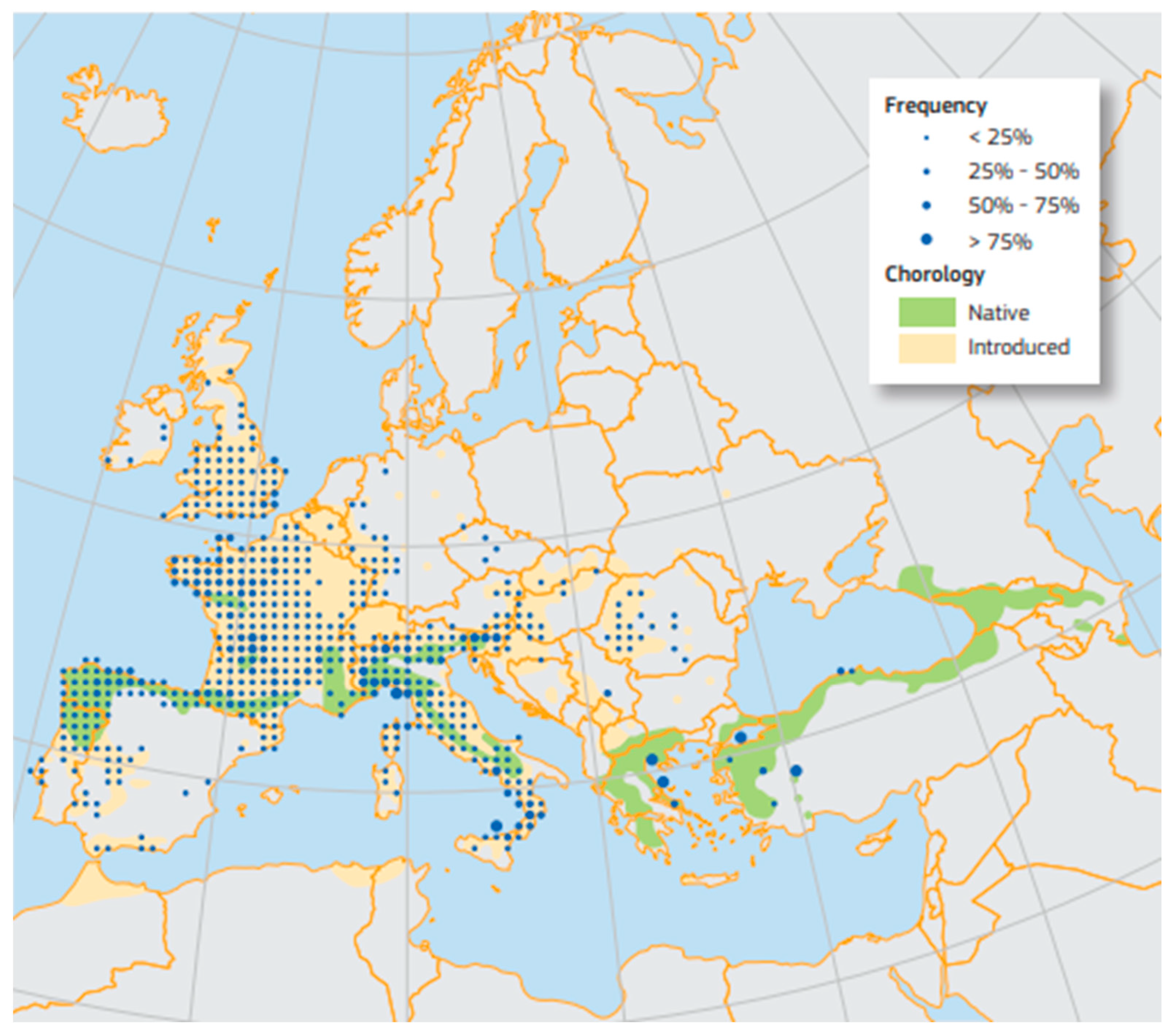
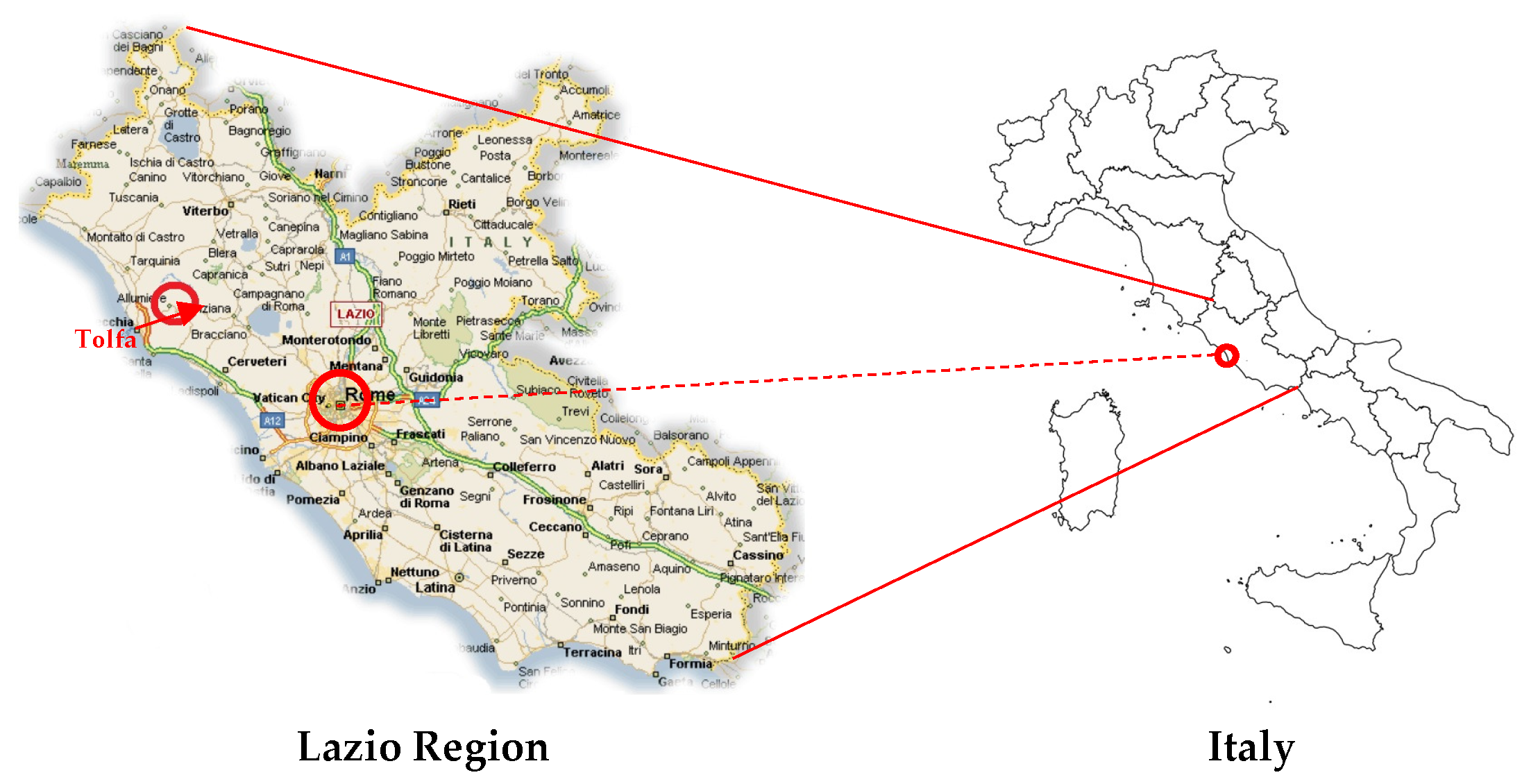
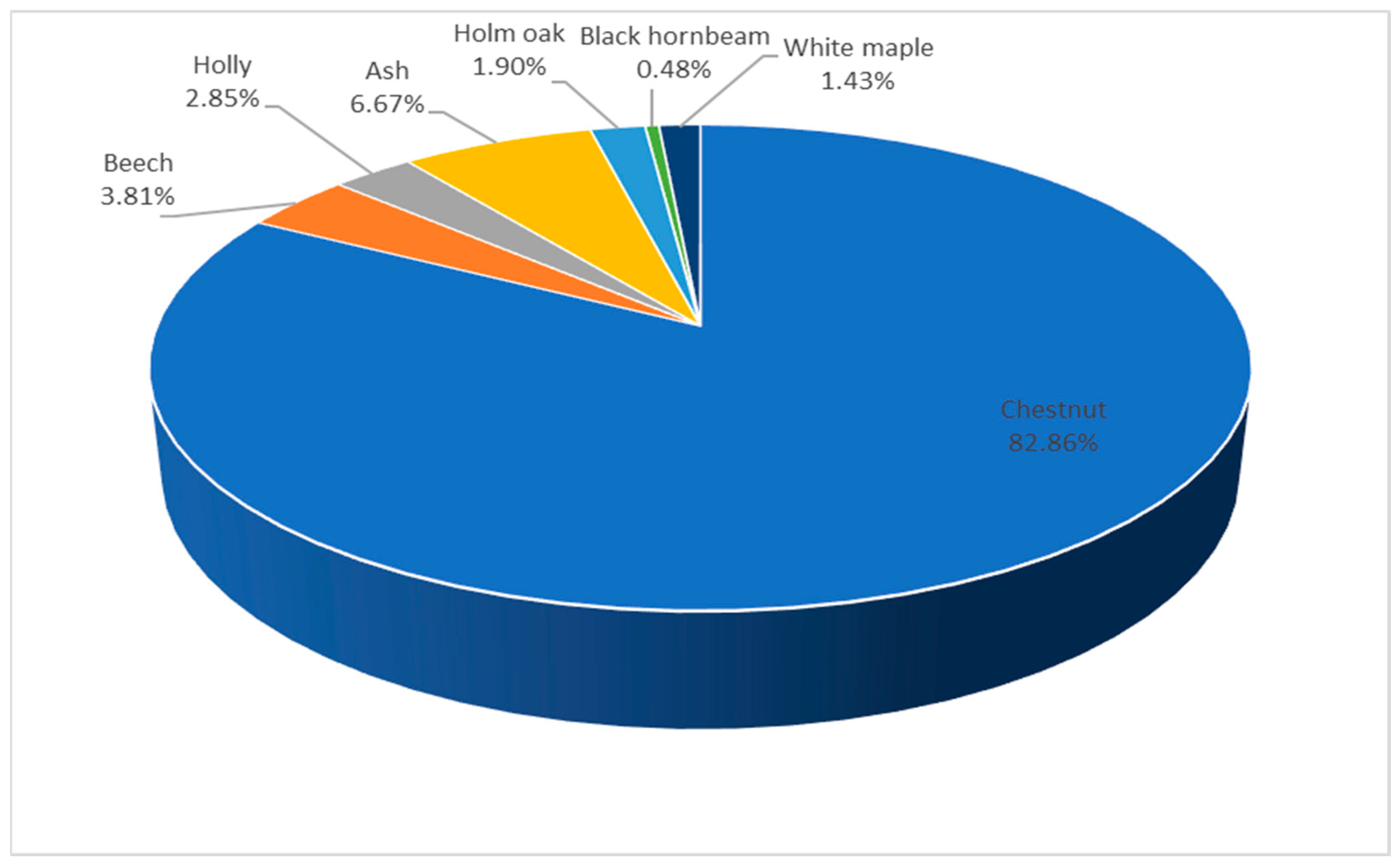
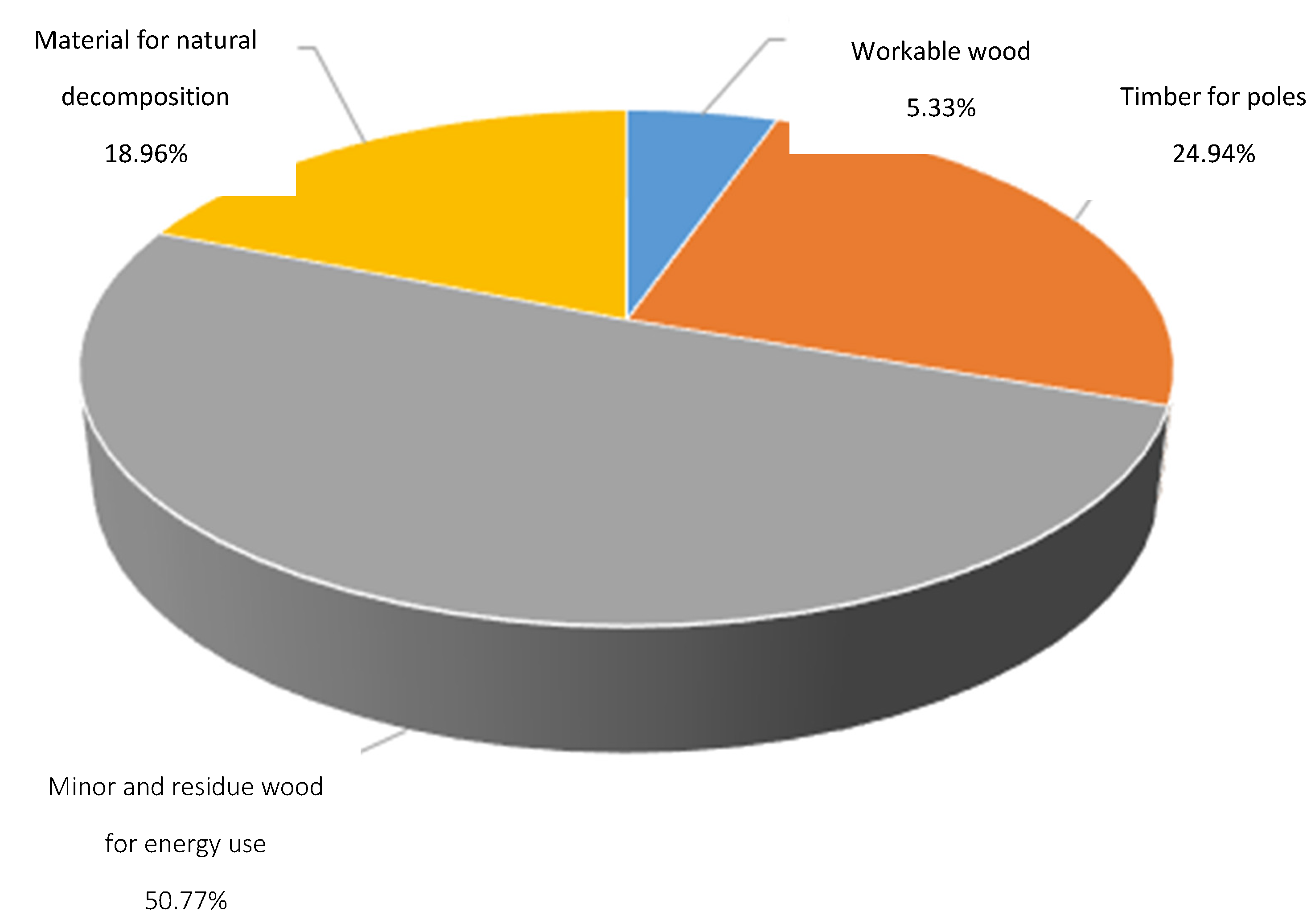
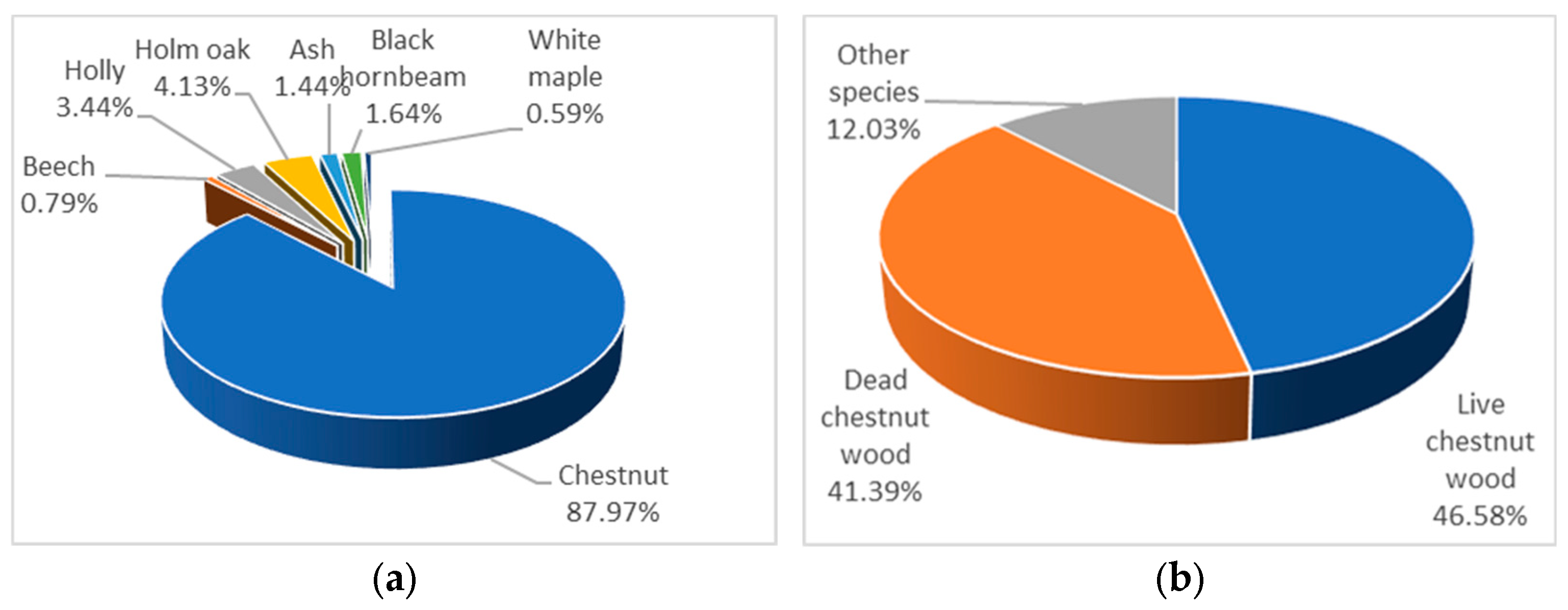
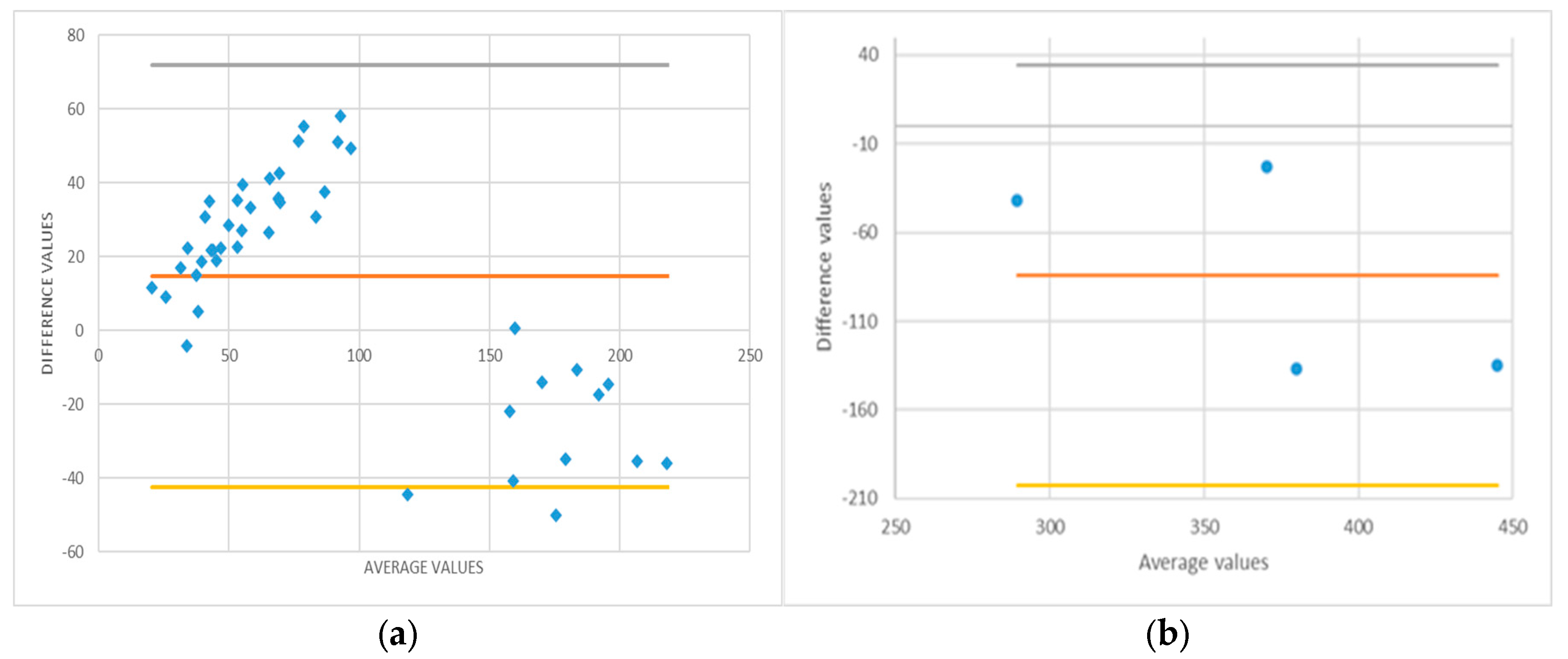
| Parameters | U of M | Expected Parameters in 2023 | Parameters Registered in 2023 |
|---|---|---|---|
| Age | 28–31 | 28–31 | |
| Average diameter | cm | 11.28 | 15.62 |
| Average height | m | 13.00 | 15.78 |
| Average basal area | m2/ha | 25.38 | 26.83 |
| Stand density | tree/ha | 2815 | 2660 |
| Expected average production | m3/ha | 164.00 | 169.23 (1) |
| Height | Diameter | |
|---|---|---|
| m | cm | |
| Min | 1.50 | 5.00 |
| Max | 4.50 | 16.00 |
| Species | Density | CO2 Absorbed | |
|---|---|---|---|
| Range of Density kg/m3 | Compute Density kg/m3 | CO2 kg | |
| Chestnut (1) | 430–580 | 607.11 (1) | 1069.48 |
| Holm oak | 710–1070 | 890 | 1564.74 |
| Holly (2) | 700–850 | 775 | 1362.55 |
| Beech | 680–970 | 825 | 1450.46 |
| Ash | 700–850 | 775 | 1362.55 |
| Black hornbeam | 620–820 | 720 | 1265.86 |
| White maple | 530–800 | 665 | 1169.16 |
| Action | Machines and Machinery | Power | Hourly Consumption (1) (Liters) | Distances (km) | Conversion Coefficient (2) CO2 eq | Emissions CO2 eq/Hour | |
|---|---|---|---|---|---|---|---|
| Forest processing | Felling | Chainsaw | Fuel | 1.25 | 2.66 | 3.3 | |
| Sectioning | Chainsaw | Fuel | 1.25 | 2.66 | 3.3 | ||
| Wood extraction | Tractor with winch | Fuel | 5.62 | 2.66 | 14.9 | ||
| Loading logs | Excavator with clamp | Fuel | 5.0 | 2.66 | 13.3 | ||
| Loading waste material | Excavator with clamp | Fuel | 5.0 | 2.66 | 13.3 | ||
| Transportation | Truck | Fuel | 52 | 2.66 | |||
| Sawmill processing | Unloading | Crane with hydraulic clamp | Fuel | 5.0 | 2.66 | 13.3 | |
| Internal handling | Crane with hydraulic clamp | Fuel | 5.0 | 2.66 | 13.3 | ||
| Sectioning workable wood | Log saw | Electricity | 0.55 | ||||
| Handling workable wood | Forklift | Fuel | 5.0 | 2.66 | 13.3 | ||
| Stacking for seasoning of workable wood | Forklift | Fuel | 5.0 | 2.66 | 13.3 | ||
| Handling seasoned workable wood | Forklift | Fuel | 5.0 | 2.66 | 13.3 | ||
| Stacking workable wood | Forklift | Fuel | 5.0 | 2.66 | 13.3 | ||
| Handling timber for poles | Forklift | Fuel | 5.0 | 2.66 | 13.3 | ||
| Stacking timber for poles | Forklift | Fuel | 5.0 | 2.66 | 13.3 | ||
| Handling residual wood | Crane with hydraulic clamp | Fuel | 5.0 | 2.66 | 13.3 | ||
| Sectioning residual wood | Semi-automatic saw | Electricity | 0.55 | ||||
| Stacking residual wood | Crane with hydraulic clamp | Fuel | 5.0 | 2.66 | 13.3 | ||
| Gate | Description | Passive | |
|---|---|---|---|
| Forest | Branches | 79,056 | |
| Wood for energy use | 163,997 | ||
| 1 | Sub-total | 243,053 | |
| Sawmill | Timber for poles | 93,928 | |
| Wood for energy use (waste) | 21,676 | ||
| Wood for energy use (trimmings) | 4969 | ||
| 2 | Sub-total | 120,572 | |
| Total | 363,625 | ||
| Actions | Total Sources Emissions | |||||||
|---|---|---|---|---|---|---|---|---|
| Direct Emissions | Collateral Emissions | |||||||
| Forest Management | Raw Material Management | Timber Management | Monitoring and Control | Operation | ||||
| Sources | Direct emissions | Forestry tools | 234.61 | 3.52 | 238.13 | |||
| Machines and machinery | 874.06 | 395.03 | 33.15 | 1288.13 | ||||
| Timber-handling vehicles | 1453.66 | 496.89 | 15.14 | 1979.81 | ||||
| Collateral emissions | Other instrumental capital | 74.40 | 1.12 | 75.52 | ||||
| Remote emissions | Capitals permanently invested and instrumental capital | 39.18 | 388.73 | 148.95 | 12.42 | 8.84 | 598.12 | |
| Total action emissions | 273.79 | 2716.45 | 1040.88 | 86.83 | 61.77 | 4179.71 | ||
| Description | Active | Passive | Balance |
|---|---|---|---|
| Accumulated CO2 | 389,745.51 | ||
| Emissions due to wood loss | 363,625.54 | ||
| Emissions due to the use of instrumental capital | 4179.71 | ||
| Balance | 389,745.51 | 367,805.25 | 21,940.26 |
| Chestnut Coppice | CO2 of the Felled Volume in the Final Cut | CO2 of Usable Volume | Environmental Performance Index | Rotation | Useful CO2 Stored Annually | Useful Volume | CO2 of Useful Volume |
|---|---|---|---|---|---|---|---|
| CO2/ha | CO2/ha | % | anni | CO2/anno | m3 | m3/ha | |
| Tolfa | 387,766.38 | 16,106.81 | 4.15% | 21.00 | 766.99 | 18.81 | 856.31 |
| Colli Albani | 547,875.00 | 107,444.00 | 19.61% | 32.00 | 3357.63 | 125.00 | 859.55 |
| Formula of Smalian | Volume Tables | Differences | |
|---|---|---|---|
| Average value | 0.115 | 0.108 | 6.10% |
| Standard deviation | 0.081 | 0.115 | −29.83% |
Disclaimer/Publisher’s Note: The statements, opinions and data contained in all publications are solely those of the individual author(s) and contributor(s) and not of MDPI and/or the editor(s). MDPI and/or the editor(s) disclaim responsibility for any injury to people or property resulting from any ideas, methods, instructions or products referred to in the content. |
© 2024 by the authors. Licensee MDPI, Basel, Switzerland. This article is an open access article distributed under the terms and conditions of the Creative Commons Attribution (CC BY) license (https://creativecommons.org/licenses/by/4.0/).
Share and Cite
Carbone, F.; Portoghesi, L.; Romagnoli, M.; Barbarese, F.; Grassi, T. Production of Chestnut Coppice Biomass in a Framework of Low Mechanization and High Expectations to Combat Climate Change and Other Social Expectations. Forests 2024, 15, 412. https://doi.org/10.3390/f15030412
Carbone F, Portoghesi L, Romagnoli M, Barbarese F, Grassi T. Production of Chestnut Coppice Biomass in a Framework of Low Mechanization and High Expectations to Combat Climate Change and Other Social Expectations. Forests. 2024; 15(3):412. https://doi.org/10.3390/f15030412
Chicago/Turabian StyleCarbone, Francesco, Luigi Portoghesi, Manuela Romagnoli, Francesco Barbarese, and Teresa Grassi. 2024. "Production of Chestnut Coppice Biomass in a Framework of Low Mechanization and High Expectations to Combat Climate Change and Other Social Expectations" Forests 15, no. 3: 412. https://doi.org/10.3390/f15030412
APA StyleCarbone, F., Portoghesi, L., Romagnoli, M., Barbarese, F., & Grassi, T. (2024). Production of Chestnut Coppice Biomass in a Framework of Low Mechanization and High Expectations to Combat Climate Change and Other Social Expectations. Forests, 15(3), 412. https://doi.org/10.3390/f15030412







